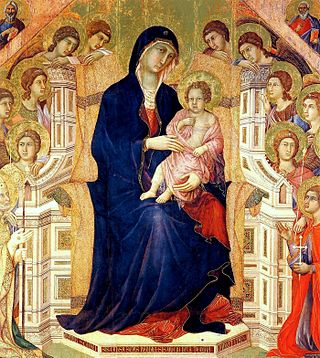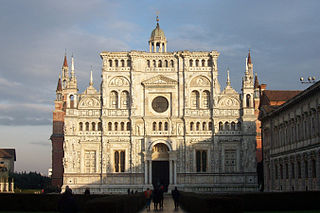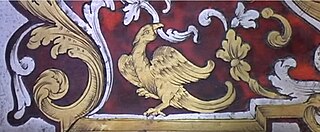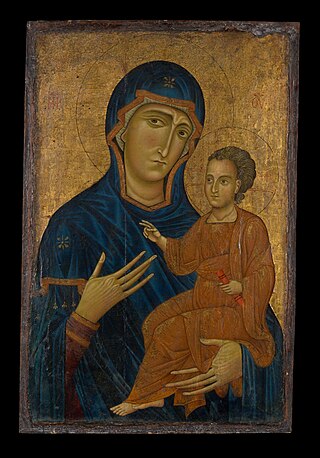
Duccio di Buoninsegna was an Italian painter active in Siena, Tuscany, in the late 13th and early 14th century. He was hired throughout his life to complete many important works in government and religious buildings around Italy. Duccio is considered one of the greatest Italian painters of the Middle Ages, and is credited with creating the painting styles of Trecento and the Sienese school. He also contributed significantly to the Sienese Gothic style.

In architecture, a corbel is a structural piece of stone, wood or metal jutting from a wall to carry a superincumbent weight, a type of bracket. A corbel is a solid piece of material in the wall, whereas a console is a piece applied to the structure. A piece of timber projecting in the same way was called a "tassel" or a "bragger" in England.
In music, montage or sound collage is a technique where newly branded sound objects or compositions, including songs, are created from collage, also known as montage. This is often done through the use of sampling, while some playable sound collages were produced by gluing together sectors of different vinyl records. In any case, it may be achieved through the use of previous sound recordings or musical scores. Like its visual cousin, the collage work may have a completely different effect than that of the component parts, even if the original parts are completely recognizable or from only one source.

Relief is a sculptural method in which the sculpted pieces are bonded to a solid background of the same material. The term relief is from the Latin verb relevo, to raise. To create a sculpture in relief is to give the impression that the sculpted material has been raised above the background plane. When a relief is carved into a flat surface of stone or wood, the field is actually lowered, leaving the unsculpted areas seeming higher. The approach requires a lot of chiselling away of the background, which takes a long time. On the other hand, a relief saves forming the rear of a subject, and is less fragile and more securely fixed than a sculpture in the round, especially one of a standing figure where the ankles are a potential weak point, particularly in stone. In other materials such as metal, clay, plaster stucco, ceramics or papier-mâché the form can be simply added to or raised up from the background. Monumental bronze reliefs are made by casting.

Andreas Bernhard Lyonel Feininger was an American photographer and a writer on photographic technique. He was noted for his dynamic black-and-white scenes of Manhattan and for studies of the structures of natural objects.

BartolomeoMontagna was an Italian Renaissance painter who mainly worked in Vicenza. He also produced works in Venice, Verona, and Padua. He is most famous for his many Madonnas and his works are known for their soft figures and depiction of eccentric marble architecture. He is considered to be heavily influenced by Giovanni Bellini, in whose workshop he might have worked around 1470. Benedetto Montagna, a productive engraver, was his son and pupil and active until about 1540. He was mentioned in Vasari's Lives as a student of Andrea Mantegna but this is widely contested by art historians.

A casket is a decorative box or container that is usually smaller than a chest and is typically decorated. In recent centuries they are often used as boxes for jewelry, but in earlier periods they were also used for keeping important documents and many other purposes. Many ancient caskets are reliquaries, for both Buddhist and Christian relics.

Bone carving is creating art, tools, and other goods by carving animal bones, antlers, and horns. It can result in the ornamentation of a bone by engraving, painting or another technique, or the creation of a distinct formed object. Bone carving has been practiced by a variety of world cultures, sometimes as a cheaper, and recently a legal, substitute for ivory carving. As a material it is inferior to ivory in terms of hardness, and so the fine detail that is possible, and lacks the "lustrous" surface of ivory. The interior of bones are softer and even less capable of a fine finish, so most uses are as thin plaques, rather than sculpture in the round. But it must always have been much easier to obtain in regions without populations of elephants, walrus or other sources of ivory.

The Certosa di Pavia is a monastery and complex in Lombardy, Northern Italy, situated near a small town of the same name in the Province of Pavia, 8 km (5.0 mi) north of Pavia. Built in 1396–1495, it was once located on the border of a large hunting park belonging to the Visconti family of Milan, of which today only scattered parts remain. It is one of the largest monasteries in Italy.

Sano di Pietro or Ansano di Pietro di Mencio (1405–1481) was an Italian painter of the Sienese school of painting. He was active for about half a century during the Quattrocento period, and his contemporaries included Giovanni di Paolo and Sassetta.

South Italian is a designation for ancient Greek pottery fabricated in Magna Graecia largely during the 4th century BC. The fact that Greek Southern Italy produced its own red-figure pottery as early as the end of the 5th century BC was first established by Adolf Furtwaengler in 1893. Prior to that this pottery had been first designated as "Etruscan" and then as "Attic." Archaeological proof that this pottery was actually being produced in South Italy first came in 1973 when a workshop and kilns with misfirings and broken wares was first excavated at Metaponto, proving that the Amykos Painter was located there rather than in Athens.

Inlay covers a range of techniques in sculpture and the decorative arts for inserting pieces of contrasting, often colored materials into depressions in a base object to form ornament or pictures that normally are flush with the matrix. A great range of materials have been used both for the base or matrix and for the inlays inserted into it. Inlay is commonly used in the production of decorative furniture, where pieces of colored wood, precious metals or even diamonds are inserted into the surface of the carcass using various matrices including clear coats and varnishes. Lutherie inlays are frequently used as decoration and marking on musical instruments, particularly the smaller strings.

Limoges enamel has been produced at Limoges, in south-western France, over several centuries up to the present. There are two periods when it was of European importance. From the 12th century to 1370 there was a large industry producing metal objects decorated in enamel using the champlevé technique, of which most of the survivals, and probably most of the original production, are religious objects such as reliquaries.

A chasse, châsse or box reliquary is a shape commonly used in medieval metalwork for reliquaries and other containers. To the modern eye the form resembles a house, though a tomb or church was more the intention, with an oblong base, straight sides and two sloping top faces meeting at a central ridge, often marked by a raised strip and decoration. From the sides there are therefore triangular "gable" areas.

The Arkesilas Painter was a Laconian vase painter active around 560 BC. He is considered one of the five great vase painters of Sparta.

Pastiglia[paˈstiʎʎa], an Italian term meaning "pastework", is low relief decoration, normally modelled in gesso or white lead, applied to build up a surface that may then be gilded or painted, or left plain. The technique was used in a variety of ways in Italy during the Renaissance. The term is mostly found in English applied to gilded work on picture frames or small pieces of furniture such as wooden caskets and cassoni, and also on areas of panel paintings, but there is some divergence as to the meaning of the term between these specialisms.

Alan Kitching RDI AGI Hon FRCA, is a practitioner of letterpress typographic design and printmaking. Kitching exhibits and lectures across the globe, and is known for his expressive use of wood and metal letterforms in commissions and limited-edition prints.

Grapham Diprose is a British photographer and author.

Italo-Byzantine is a style term in art history, mostly used for medieval paintings produced in Italy under heavy influence from Byzantine art. It initially covers religious paintings copying or imitating the standard Byzantine icon types, but painted by artists without a training in Byzantine techniques. These are versions of Byzantine icons, most of the Madonna and Child, but also of other subjects; essentially they introduced the relatively small portable painting with a frame to Western Europe. Very often they are on a gold ground. It was the dominant style in Italian painting until the end of the 13th century, when Cimabue and Giotto began to take Italian, or at least Florentine, painting into new territory. But the style continued until the 15th century and beyond in some areas and contexts.

The Embriachi workshop was an important producer of objects in carved ivory and carved bone, set in a framework of inlaid wood, in north Italy from around 1375 to perhaps as late as 1433, apparently moving from Florence to Venice about 1395. They are especially known for what are now called marriage caskets or wedding caskets, hexagonal or oblong caskets about a foot across, with lids that rise up in the centre. Their output of these was probably made for stock rather than individual commissions, and filled a market for gifts for betrothals and weddings. They sold mirrors framed in a similar style, though fewer of these have survived, and religious pieces both small and in a few cases very large.



















